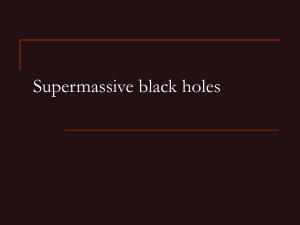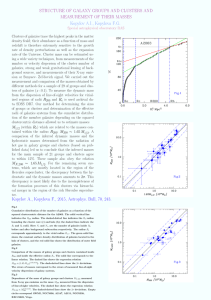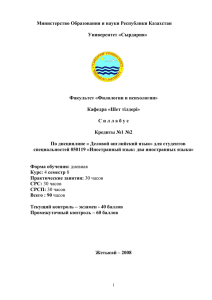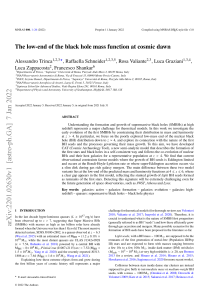Родительские галактики гамма-всплесков и космология
реклама
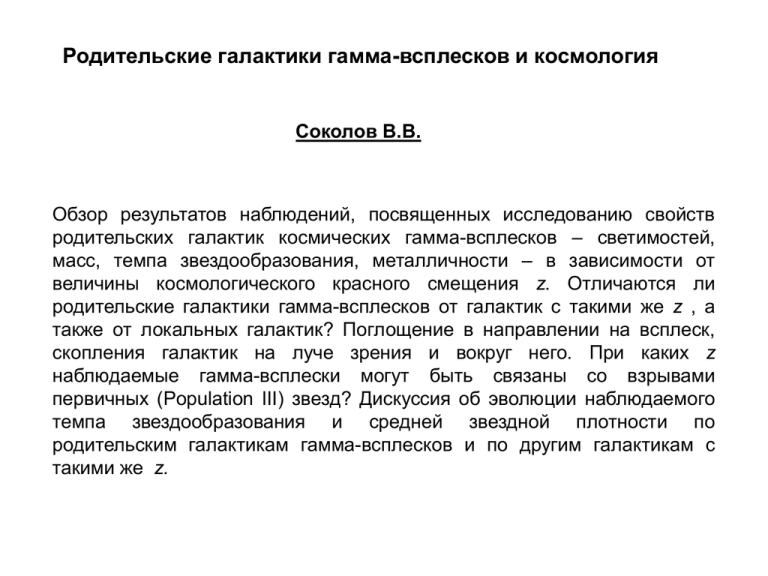
Родительские галактики гамма-всплесков и космология Соколов В.В. Обзор результатов наблюдений, посвященных исследованию свойств родительских галактик космических гамма-всплесков – светимостей, масс, темпа звездообразования, металличности – в зависимости от величины космологического красного смещения z. Отличаются ли родительские галактики гамма-всплесков от галактик с такими же z , а также от локальных галактик? Поглощение в направлении на всплеск, скопления галактик на луче зрения и вокруг него. При каких z наблюдаемые гамма-всплески могут быть связаны со взрывами первичных (Population III) звезд? Дискуссия об эволюции наблюдаемого темпа звездообразования и средней звездной плотности по родительским галактикам гамма-всплесков и по другим галактикам с такими же z. The first afterglow spectral obs for long GRB 970508 U T0 + 4 h GRB 970508 + 23 days TT 0 0+ 454 days WHT R T0 + 4 h 2.2 CAHA (Pian et al. (Metzger et1998) al. 1997) (Fruchter 2000) (Castro-Tirado et al. 1998, Science 279, 1011.) HST HST GRB 970508 at z < 0.835: First Sp cosmol. origin evi.! astro-ph/1212.0144 S. Savaglio A&A, 337, 356 (1998) BVRcIc light curves of GRB970508 optical remnant and colors of underlying host galaxy S.Zharikov, V. Sokolov, and Yu.Baryshev A&A, 372, 438 (2001) Properties of the host galaxy of the gamma-ray burst 970508 and local star-forming galaxies V.Sokolov, S.Zharikov, Yu.Baryshev, M.O. Hanski, K. Nilsson, P. Teerikorpi, L. Nicastro, and E. Palazzi The Rc band field near GRB 970508 optical source. The image size is 33′′ × 33′′. N -top, E-right. The G1, G2, G3 are nearby galaxies. The arrow denotes an optical remnant of GRB970508. Multi-color photometry and the Rc image of the GRB 980703 host galaxy field from BTA observations in July 1998. The comparison of energy distribution obtained from BVRcIc fluxes (with consideration for the shift in the ultra-violet part of spectrum for z=0.966) of this galaxy with energy distribution in spectra of galaxies of different Hubble types is shown. (The FWHM of each filter for its λeff with consideration for its left shift for z=0.966 are denoted by dotted horizontal segments with bars.) The massive SFR is seen in rest frame UV part spectra of star-forming galaxies. It is just a light of massive stars in the GRB hosts… The population synthesis modeling: Comparison of modeled and observed fluxes in the filters B, V, Rc, Ic, J, H, K for the GRB 980703 host galaxy (z=0.9662). If GRBs are associated with an active star formation, then we might expect the light of their host galaxies to be affected by internal extinction. The population synthesis modeling: A&A, 2001, 372, 438, by V.Sokolov, T.Fatkhullin, A.J.Castro-Tirado, A.S.Fruchter et al. (z=0.9662) A&A, 2001, 372, 438, by V.Sokolov et al. Extinction curves for the reddening laws. Cardelli extinction law represents the reddening in Milky Way, while Calzetti law was derived empiracally from a sample of integrated spectra of starburst galaxies Astro-ph/1102.1469, Fig.A.2 from Tayyaba Zafar, Darach Watson1, Johan P. U. Fynbo, Daniele Malesani, P´all Jakobsson , and Antonio de Ugarte Postigo The optical spectrum of the afterglow of GRB080607 (z =3.0368) was obtained with the Keck. Bull. Spec. Astrophys. Obs., 2001, 51, 48-50 • • GRB 970508 host, MB rest = – 18.62 GRB 980703 host, MB rest = – 21.27 Bull. Spec. Astrophys. Obs., 2001, 51, 48-60 and 38-47 (astro-ph/0107399) The observed R-band magnitude vs. spectroscopic redshift for the first 12 GRB host galaxies. The BTA R-band magnitudes (from Sokolov et al, 2001, A&A 372, 438 ) are marked with circles, while asterisks refer to the results of other authors. • Also the HDF F606W magnitude vs.photometrical redshift distribution is plotted. Catalog of the F606W magnitudes and photometrical redshifts was used from Fernández-Soto et al., 1999 • 2001 2006-2009 ! The “simple” (but brawl) conclusion: • It is shown that these galaxies are usual ones with a high star formation rate, they are mainly observed in optical at redshifts about 1 and higher. V. V. Sokolov, T. A. Fatkhullin, A. J. Castro-Tirado, A. S. Fruchter et al., 2001 • GRB hosts should not to be special, but normal star-forming galaxies (the most abundant), detected at any z just because a GRB event has occurred • • see S.Savaglio et al., 2006-2009 The monitoring of GRB afterglows and the study of their host galaxies with the SAO RAS 6-m telescope from 1997 V. Sokolov et al. ● The first result of the GRB optical identification (with objects already known before): GRBs are identified with ordinary (or the most numerous in the Universe) galaxies up to 28 st. magnitudes and more. The GRB hosts should not be special, but normal field star forming galaxies at comparable redshifts and magnitudes. Astronomy of GRBs with the 6-m telescope from 1998 SN 1998bw and Astronomy of γ-ray bursts with the 6-m telescope -------------------------------- GRBs and SNe with spectroscopically confirmed connection: GRB 980425/SN 1998bw (z=0.0085), GRB 030329/SN 2003dh (z=0.1687), GRB 031203/SN 2003lw (z=0.1055), GRB/XRF 060218/SN2006aj (z=0.0335) XRF 080109/SN2008D (z=0.0065) GRB 100316D/SN2010bh (z=0.059) + the numerous phot. confirmations Searching for more Sp. confirmed pairs of GRBs (XRFs) and SNe in future observations is very important for understanding the nature of the GRB-SN connection, the nature of GRBs, and the mechanism of core-collapse SNe explosion (see more in the posters…) GRB 030329/SN 2003dh SN 2006aj/ GRB 060218, Δt = v = 33,000 km s-1 2.55 d. FeIII, FeII FeIII, FeII TiII, CaII HeI Hα SiII v~r CII OI XRF080109/SN 2008D, 6.48 days after the trigger Velocity at the photosphere, as inferred from Fe II lines, is plotted against time after maximum light. The line is a power-law fit to the data, with SN 1998dt at 32 days (open circle) excluded (Figure 22 from Branch, D. et al. 2002, ApJ, 566, 1005). Squares (SN 2008D) and Diamonds (SN 2006aj) are photosphere velocities, inferred from our spectra. astro-ph/1301.0840 The first result of the GRB optical identification (with objects already known before): GRBs are identified with ordinary (or the most numerous in the Universe) galaxies up to 28 st. magnitudes and more. The GRB hosts should not be special, but normal field star-forming galaxies at comparable redshifts and magnitudes. The second result of the GRB identification: now the long-duration GRBs are identified with (may be) ordinary (massive) core-collapse supernovae (CCSNe, see in the poster report). So, we have the massive star-forming in GRB hosts and massive star explosions – CC-SN/GRB The popular conception of the relation between long-duration GRBs and core-collapse SNe (the picture from Woosley and Heger , 2006) Shematic model of asymmetric explosion of a GRB/SN progenitor …a strongly nonspherical explosion may be a generic feature of core-collapse supernovae of all types. …Though while it is not clear that the same mechanism that generates the GRB is also responsible for exploding the star. astro-ph/0603297 Leonard, Filippenko et al. The shock breaks out through the wind The wind envelope of size ~1013 cm 56Ni synthesized behind the shock wave Though the phenomenon (GRB) is unusual, but the object-source (SN) is not too unique. The closer a GRB is, the more features of a SN. The search for differences between nearby SNe identified with GRBs and distant SNe which are to be identified with GRBs can be an additional observational cosmological test. We can ask a question analogous to that on GRB hosts: Do GRB SNe differ from usual (e.g. local) SNe? What are redshifts at which CC-SNe are quite different from local CC-SNe? It could be the third important result of the GRB identification. Astronomy of GRBs with the 6-m telescope from 1998 GRB 090429B на z = 9.4 (Cucchiara et al. 2011) GRB 090423 на z = 8.26 (Salvaterra et al. 2009; Tanvir et al. 2009), GRB 080913 на z = 6.7 (Greiner et al. 2009), GRB 050904 на z = 6.3 (Kawai et al. 2006; Totani et al. 2006) (Самое большоее красное смещение квазаров z = 7.085 (Mortlock et al. 2011) и z = 6.41 (Willott et al. 2003).) Chandra et al. (2010) сообщили об открытии послесвечения в радиодиапазоне (SNe?) от GRB 090423 (z=8.26), а Frail et al. (2006) для GRB 050904 (z = 6.3). Наблюдения послесвечений позволяют определить физические свойства взрыва и околозвездной среды. Интересно было бы поискать такие разные признаки в послесвечениях GRB на больших и малых красных смещениях. astro-ph/1301.0840 astro-ph/1301.4908 arXiv:astro-ph/0309217, Yonetoku et al. The distribution of luminosity vs. redshift derived from the Ep– luminosity relation. The truncation(усечение) of the lower end of the luminosity is caused by the flux limit of Flimit = 1 × 10^−7 erg cm^−2s^−1. The inserted figure is the cumulative luminosity function in the several redshift ranges. The luminosity evolution exists because the breakluminosity increase toward the higher redshift. astro-ph/1201.6383 The monitoring of GRB afterglows and the study of their host galaxies with the SAO RAS 6-m telescope from 1997 V. Sokolov et al. ● The first result of the GRB optical identification (with objects already known before): GRBs are identified with ordinary (or the most numerous in the Universe) galaxies up to 28 st. magnitudes and more. The GRB hosts should not be special, but normal field star forming galaxies at comparable redshifts and magnitudes. (2011) arXiv:astro-ph/1011.4506 F. Mannucci, R. Salvaterra, M. A. Campisi We have compared the metallicity properties of a sample of 18 GRB host galaxies with those of the local field population. In particular, we have found that GRB hosts do follow the Fundamental Metallicity Relation (FMR) recently found by Mannucci et al. (2010). This fact implies that GRB hosts do not differ substantially from the typical galaxy population. The typical low, sub-solar metallicity found in many recent studies (e.g., Savaglio et al. 2009; Levesque et al. 2010b and references therein) does not necessary mean that GRBs occur in special, low metallicity galaxies, as the exception of GRB 020819 (with 12 + log(O/H) = 8.9) clearly shows , and that a direct link between low metallicity and GRB production exists. arXiv:astroph/1011.4506 И основные выводы по GRB-галактикам: • Если GRBs отождествляются с обычными галактиками, то • GRB-hosts – инструмент… arXiv:0911.1356, by Labbe et al. (2009) Broadband SEDs of the z ~ 7 z850−dropout galaxies from our NICMOS, WFC3/UDF and WFC3/ERS samples, averaged in 1−mag bins centered on H160 26, 27 and 28. The data include HST ACS, NICMOS, and FC3/IR, groundbased K, and IRAC [3.6] and [4.5]. The best-fit BC03 stellar population models at z = 6.9 are shown. The overall SED shapes are remarkably similar, with a Balmer break between H160 and [3.6], indicative of evolved stellar populations (> 100Myr). The far−UV slope (traced by 125 − H160) bluens significantly towards fainter H160 magnitude (as found Bouwens et al. 2009b). Upper limits are 2. ACS optical measurements are non-detections fainter than 29.4 mag. arXiv:astro-ph/0309217, Yonetoku et al. The distribution of luminosity vs. redshift derived from the Ep– luminosity relation. The truncation(усечение) of the lower end of the luminosity is caused by the flux limit of Flimit = 1 × 10^−7 erg cm^−2s^−1. The inserted figure is the cumulative luminosity function in the several redshift ranges. The luminosity evolution exists because the breakluminosity increase toward the higher redshift. 1109.0990, Главное в докладе: The connection between the rate of GRBs ˙nGRB(z) and ˙ρ⋆(z), ˙nGRB(z) = ψ(z) ˙ρ⋆(z) Robertson B. E. & Ellis R. C., ApJ 744, 95 (2012) arXiv:1109.0990, Robertson & Ellis …the GRB-derived star formation rate, clearly exceed the stellar mass density ρstar at all redshifts. GRB 090429B на z = 9.4 (Cucchiara et al. 2011) является в настоящее время рекордным объектом, GRB 090423 на z = 8.26 (Salvaterra et al. 2009; Tanvir et al. 2009), GRB 080913 на z = 6.7 (Greiner et al. 2009), GRB 050904 на z = 6.3 (Kawai et al. 2006; Totani et al. 2006) (Самое большоее красное смещение квазаров z = 7.085 (Mortlock et al. 2011) и z = 6.41 (Willott et al. 2003).) Chandra et al. (2010) сообщили об открытии послесвечения в радиодиапазоне (SNe?) от GRB 090423 (z=8.26), а Frail et al. (2006) для GRB 050904 (z = 6.3). Наблюдения послесвечений позволяют определить физические свойства взрыва и околозвездной среды. Интересно было бы поискать такие разные признаки в послесвечениях GRB на больших и малых красных смещениях. astro-ph/1108_0674_!!!_ astro-ph/1303.0844 X-ray absorption evolution in Gamma-Ray Bursts: intergalactic medium or evolutionary signature of their host galaxies? astro-ph/1303.0844 • This naturally led to the suggestion that excess X-ray absorption could be used as some kind of redshift indicator, • at least in the sense that bursts with high excess would be expected to be at low redshift (Grupe et al. 2007). • In practice, this indicator has proven of limited value, in part because in many cases the measurement uncertainties are quite high, • but more pertinently(уместный) for this work, also because many higher redshift bursts exhibit surprisingly high excess absorption. astro-ph/1303.0844 Figure 5 astro-ph/1303.0844 • Figure 1. Intrinsic X-ray column density, NH,intrinsic, as a function of redshift, z, as measured in absorbed power law fits to 198 Swift XRT-observed GRB afterglows up to 2012 September 1 with reported redshifts and PC mode spectra (see Footnote 1). • Central values of the column density are represented by filled circles, and error bars are shown at the 90% confidence level. • Measured intrinsic absorption is denoted by black data points while upper limits are shown in red. • An indication of the minimum detectable NH,intrinsic with redshift is shown by the grey dashed line, for NH = 10^19 cm−2. GRB 090429B на z = 9.4 (Cucchiara et al. 2011) , GRB 090423 на z = 8.26 (Salvaterra et al. 2009; Tanvir et al. 2009), GRB 080913 на z = 6.7 (Greiner et al. 2009), GRB 050904 на z = 6.3 (Kawai et al. 2006; Totani et al. 2006) astro-ph/1303.0844 astro-ph/1303.0844 astro-ph/1303.0844 7.2 A Population III star progenitor for z = 8 – 9 GRBs? The search for, and understanding of, the very first population of stars and galaxies is one of the central questions of astrophysics (e.g. Barkana & Loeb 2001; Bromm & Larson 2004; Ciardi & Ferrara 2005; Glover 2005). If found, these sources will indicate the time at/over which the Universe was reionised and provide a means of studying the conditions at that crucial epoch in its history. The epoch of reionisation is currently suggested to have occurred around z ∼ 10 as measured with the Wilkinson Microwave Anisotropy Probe (Hinshaw et al. 2012; Dunkley et al. 2009; Komatsu et al. 2009), but this is subject to very large uncertainty and debate whilst observational signatures are lacking (e.g. Persson et al. 2010). astro-ph/1303.0844 • The first stars are predicted to have been very massive: • > 100 M⊙ (Population III, • Abel et al. 2000; Bromm & Larson 2004; Bromm et al. 2009) • and > 10 M⊙ (termed Population II.5 or III.2 • e.g. Greif & Bromm 2006; Tan & McKee 2008), • perhaps capable of producing a supernova and a GRB • in their final demise [dɪ'maɪz] (Heger & Woosley 2002; • Heger et al. 2003; Greif et al. 2007; • M´esz´aros & Rees 2010 considering z = 20). The immense(огромный) luminosities of most GRBs, • of order 10^51 erg, mean that we are likely to be able to detect them beyond z = 11, • perhaps to z ∼ 14 − 20 (e.g. Bloom et al. 2009). astro-ph/1303.0844 “zero metallicity” не проходит! • If we consider the case • that all the excess X-ray column density we measure • in our highest redshift GRBs, • 090423 and 090429B, • is intrinsic to the GRB host galaxy, • then a number of arguments leads us to conclude • that a Population III star (is) progenitor for each of these GRB events • seems highly unlikely, • although cannot be ruled out. • The intrinsic column densities we measure • in GRBs 090423 and 090429B • become very large when zero metallicity is invoked (Section 3) • suggesting that • metals are likely to have been present at redshifts 8–9, • and therefore • the environment at the epoch of these bursts was not pristine. astro-ph/1303.0844 • Certain formation scenarios for the first stars suggest • that it would be extremely difficult to obtain • ∼10^24 cm−2 column densities • around Population III stars (e.g. Greif et al. 2009). • Recent SPH simulations by Salvaterra et al. (2011) • imply rapid metal enrichment occurred by z = 7 − 8. • Their simulations dictate that at those redshifts, • where we find GRB090423, • galaxies can have metallicities of a tenth Solar • and all long GRBs would originate in Population II stars. • Our findings show that, at Z ∼ 1/10 Z⊙ • with no intervening absorber contribution, • GRB 090423 • must have an intrinsic X-ray column density • of few×10^23 cm−2, • and is therefore likely to lie • in a region with high local gas densities in this scenario. astro-ph/1303.0844 Additionally, given the significant role that ionisation may play, we should consider that the X-ray column densities we measure • are in fact lower limits (see e.g. Watson & Laursen 2011). The absorbing gas close to the GRB • should be strongly ionised • by the blast of high energy radiation from the GRB jet, • while what we measure • is the equivalent neutral hydrogen column density. Crude lower limits on the metallicity • can be made by assuming the material is Thomson thin • (e.g. Campana et al. 2011) • and all located within the GRB host galaxy. Using this method on GRBs 090423 and 090429B • we find Z > 0.05 and Z > 0.03 respectively • (using the 90% uncertainties on NH,intrinsic • from the best-fitting models to the SEDs). astro-ph/1303.0844 In summary, • should all the observed X-ray absorption • originate in the circumburst medium, • a Population III progenitor for the GRBs in our sample • at redshift 8 and above • is unlikely • given the large column densities this would imply. • The NH−z relation we investigate here • implies that at even higher redshifts • where we should find the first stars, • column densities will remain higher • than those achieved in current Population III star scenarios • when zero metallicity is invoked. A combination of intrinsic and intervening absorption contributing to the spectral shape observed in these high-redshift sources may therefore be preferable. ApJ, 2009, 691, 182, SAVAGLIO, GLAZEBROOK, & LE BORGNE Figure 18. Metallicity as a function of redshift (lower x-axis) or Hubble time (upper x-axis). The filled circles in the left and right side plots are GRB-host metallicities determined with the R23 calibration, when choosing the lower and upper branch solutions, respectively. The filled triangles are GRB hosts with the Te and O3N2 metallicities. The filled stars are GRB-DLA metallicities, derived from the absorption lines detected in the afterglow spectra. The open squares are DLA metallicities measured in QSO spectra. The solid and dashed lines represent the linear correlation for GRB-DLAs and QSO-DLAs, respectively (see Savaglio 2006). astro-ph/1303.0844 Figure 5 astro-ph/1303.0844 astro-ph/1303.0844 arXiv:0911.1356, by Labbe et al. (2009) Broadband SEDs of the z ~ 7 z850−dropout galaxies from our NICMOS, WFC3/UDF and WFC3/ERS samples, averaged in 1−mag bins centered on H160 26, 27 and 28. The data include HST ACS, NICMOS, and FC3/IR, groundbased K, and IRAC [3.6] and [4.5]. The best-fit BC03 stellar population models at z = 6.9 are shown. The overall SED shapes are remarkably similar, with a Balmer break between H160 and [3.6], indicative of evolved stellar populations (> 100Myr). The far−UV slope (traced by 125 − H160) bluens significantly towards fainter H160 magnitude (as found Bouwens et al. 2009b). Upper limits are 2. ACS optical measurements are non-detections fainter than 29.4 mag. May be no steep drop exists in the Z/Zʘ up to z ~ 7. Mg II & Clasters astro-ph/1212.0144 S. Savaglio The first afterglow spectral obs for long GRB 970508 U T0 + 4 h GRB 970508 + 23 days TT 0 0+ 454 days WHT R T0 + 4 h 2.2 CAHA (Pian et al. (Metzger et1998) al. 1997) (Fruchter 2000) (Castro-Tirado et al. 1998, Science 279, 1011.) HST HST GRB 970508 at z < 0.835: First Sp cosmol. origin evi.! astro-ph/1212.0144 S. Savaglio Для этого всплеска дублет MgII 2800A отождествляется один раз с z = 0.835, и второй раз с z = 0.767 Какая-то из соседних галактик (G1, G2, G3) попала в щель спектрографа и дала второй дублет MgII 2800A (вместе с его спутником MgI 2850A) с z = 0.767 Ближайшая галактика G2 (этого скопления?) находится в ~4” от родительской галактики GRB 970508 с z = 0.767 A&A, 337, 356 (1998) BVRcIc light curves of GRB970508 optical remnant and colors of underlying host galaxy S.Zharikov, V. Sokolov, and Yu.Baryshev A&A, 372, 438 (2001) Properties of the host galaxy of the gamma-ray burst 970508 and local star-forming galaxies V.Sokolov, S.Zharikov, Yu.Baryshev, M.O. Hanski, K. Nilsson, P. Teerikorpi, L. Nicastro, and E. Palazzi The Rc band field near GRB 970508 optical source. The image size is 33′′ × 33′′. N -top, E-right. The G1, G2, G3 are nearby galaxies. The arrow denotes an optical remnant of GRB970508. Мы сразу начали с того, что сравнили свойства этих галактик со свойствами ГРБ-галактики… The monitoring of GRB afterglows and the study of their host galaxies with the SAO RAS 6-m telescope from 1997 V. Sokolov et al. И мы тогда уже сравнили свойства этих галактик… Полезно посмотреть на весь этот спектр. Но для доклада главное то, что относится к знаменитому дублету MgII, который обнаружен командой Альберто в этом спектре аж два раза (см. на предыдущий слайд и читай подпись): astro-ph/0506101 ! А тут намечается тот же дублет (и с тем же расстоянием между компонентами), но при z = 0.57 GRB 021004 field Радиальное распределение красных смещений галактик dN (z, dz) для dz=0.2 и 0.3 в глубоком поле GRB 021004 Наблюдаемое отклонение и пуассоновский шум для dz = 0.2 и 0.3 Широкоугольные обзоры и глубокие поля: положение на небе Широкоугольные обзоры и глубокие поля: SDSS Main Galaxy Redshift Survey and Deep Fields GRB 021014 field & SDSS III Широкоугольные обзоры и глубокие поля: положение на небе Anderson et al. 2012 , MNRAS, 427, 3435 Распределение выбранных в этом поле галактик со средним Z = 0.57 Получается, что такая стена (из скоплений галактик) продолжается до места нашей площадки? Ну а дальше пошла интерпретация … Astro-ph/1303.4666 Anderson et al. Широкоугольные обзоры и глубокие поля: SDSS Main Galaxy Redshift Survey and Deep Fields Широкоугольные обзоры и глубокие поля: положение на небе The MgII problem astro-ph/1211_6528 Astro-ph/1301.0646 astro-ph/1301.0646 The MgII problem astro-ph/1301.0646 astro-ph/1301.0646 ! The “simple” (but brawl) conclusion: • It is shown that these galaxies are usual ones with a high star formation rate, they are mainly observed in optical at redshifts about 1 and higher. V. V. Sokolov, T. A. Fatkhullin, A. J. Castro-Tirado, A. S. Fruchter et al., 2001 • GRB hosts should not to be special, but normal star-forming galaxies (the most abundant), detected at any z just because a GRB event has occurred • • see S.Savaglio et al., 2006-2009 Темп звездообразования (SFR) и темп гамма-всплесков (GRBR) на больших красных смещениях: Быстрого падения SFR нет вплоть до z ~ 10. Крутого падения Z/Zʘ нет вплоть до z ~ 7. (Наблюдается ли эволюция чего-либо с ростом красного смещения Z?) Richard Phillips Feynman (1918 – 1988) «Science is a culture of doubt» «Knowledge can progress only if people have open minds and test their ideas. So far so good.» Lev Davidovich Landau (1908 – 1968) «Cosmologists are often in error but never in doubt» The population synthesis modeling: A&A, 2001, 372, 438, by V.Sokolov, T.Fatkhullin, A.J.Castro-Tirado, A.S.Fruchter et al. (z=0.9662) И подтверждение поглощения около 2175 А для родительских галактик гамма-всплесков с z > 1: Astro-ph/1102.1469, Fig.A.2 from Tayyaba Zafar, Darach Watson1, Johan P. U. Fynbo, Daniele Malesani, P´all Jakobsson , and Antonio de Ugarte Postigo GRB070802 (z = 2.4541) afterglow were obtained with the VLT/FORS2. The 2175Å dust extinction feature is clearly seen in the optical spectrum of the afterglow. Astro-ph/1102.1469, Fig.A.2 from Tayyaba Zafar, Darach Watson1, Johan P. U. Fynbo, Daniele Malesani, P´all Jakobsson , and Antonio de Ugarte Postigo The optical spectrum of the afterglow of GRB080607 (z =3.0368) was obtained with the Keck. A&A, 2001, 372, 438, by V.Sokolov et al. Extinction curves for the reddening laws. Cardelli extinction law represents the reddening in Milky Way, while Calzetti law was derived empiracally from a sample of integrated spectra of starburst galaxies astro-ph/1303.0844
